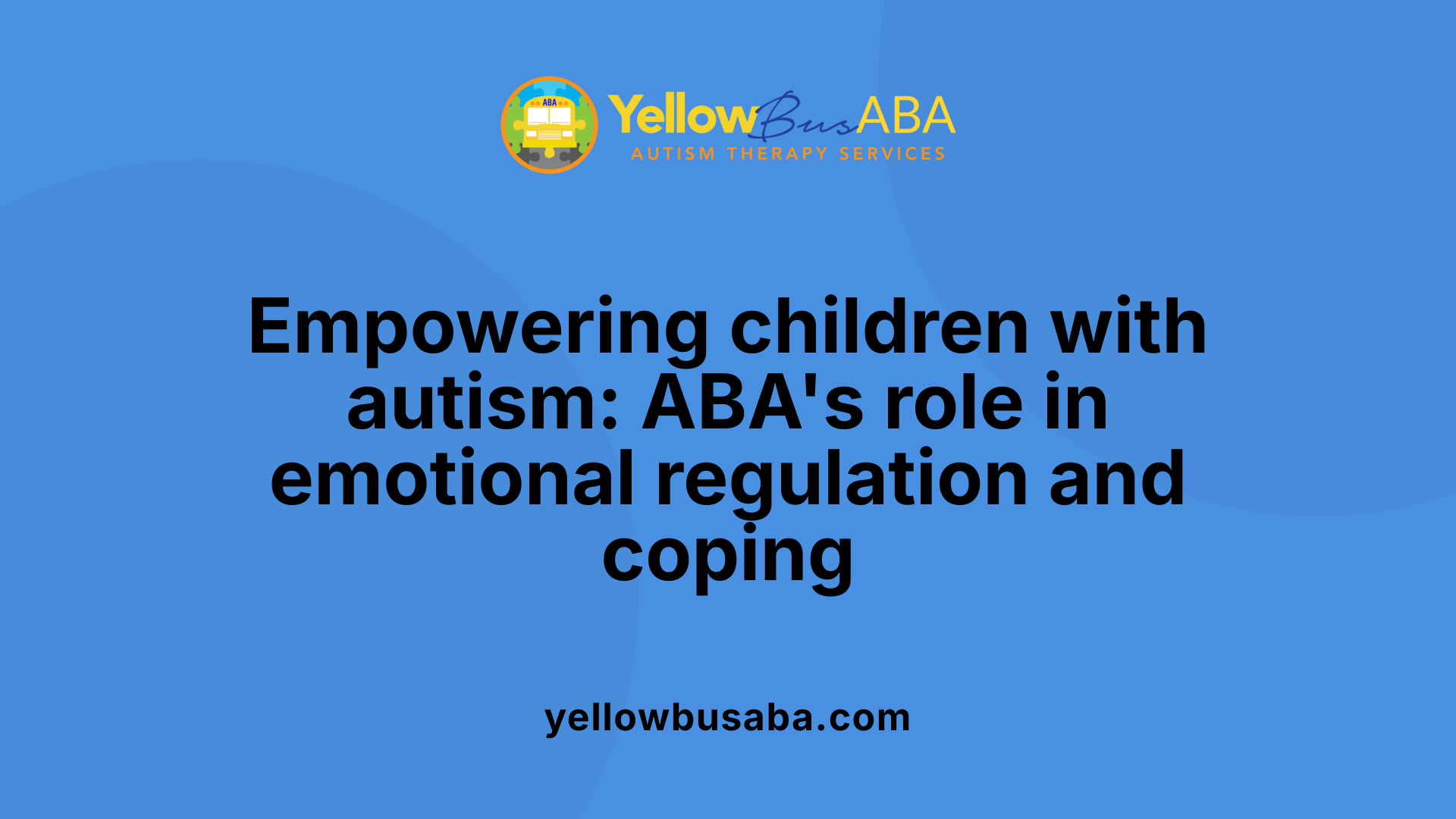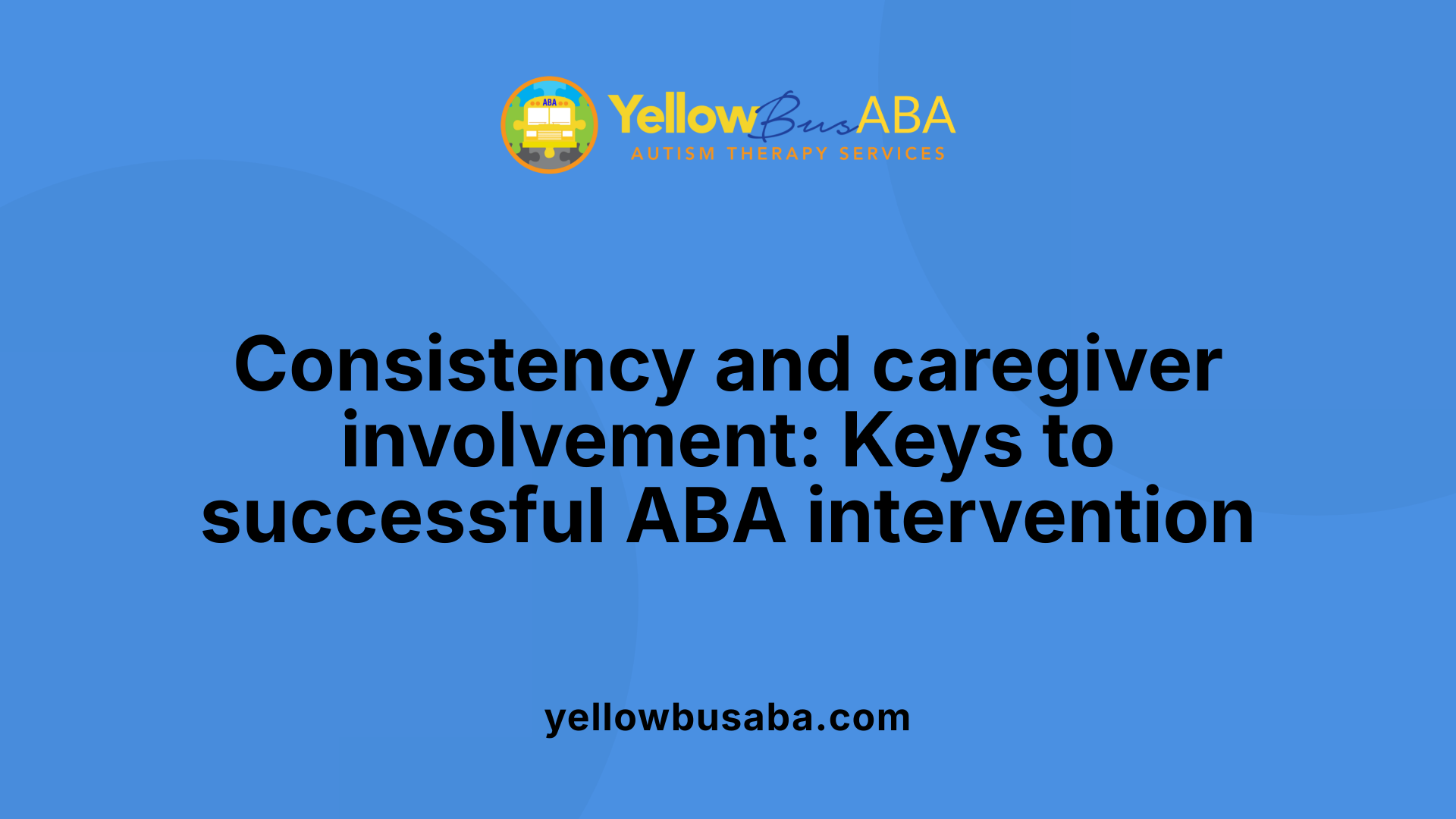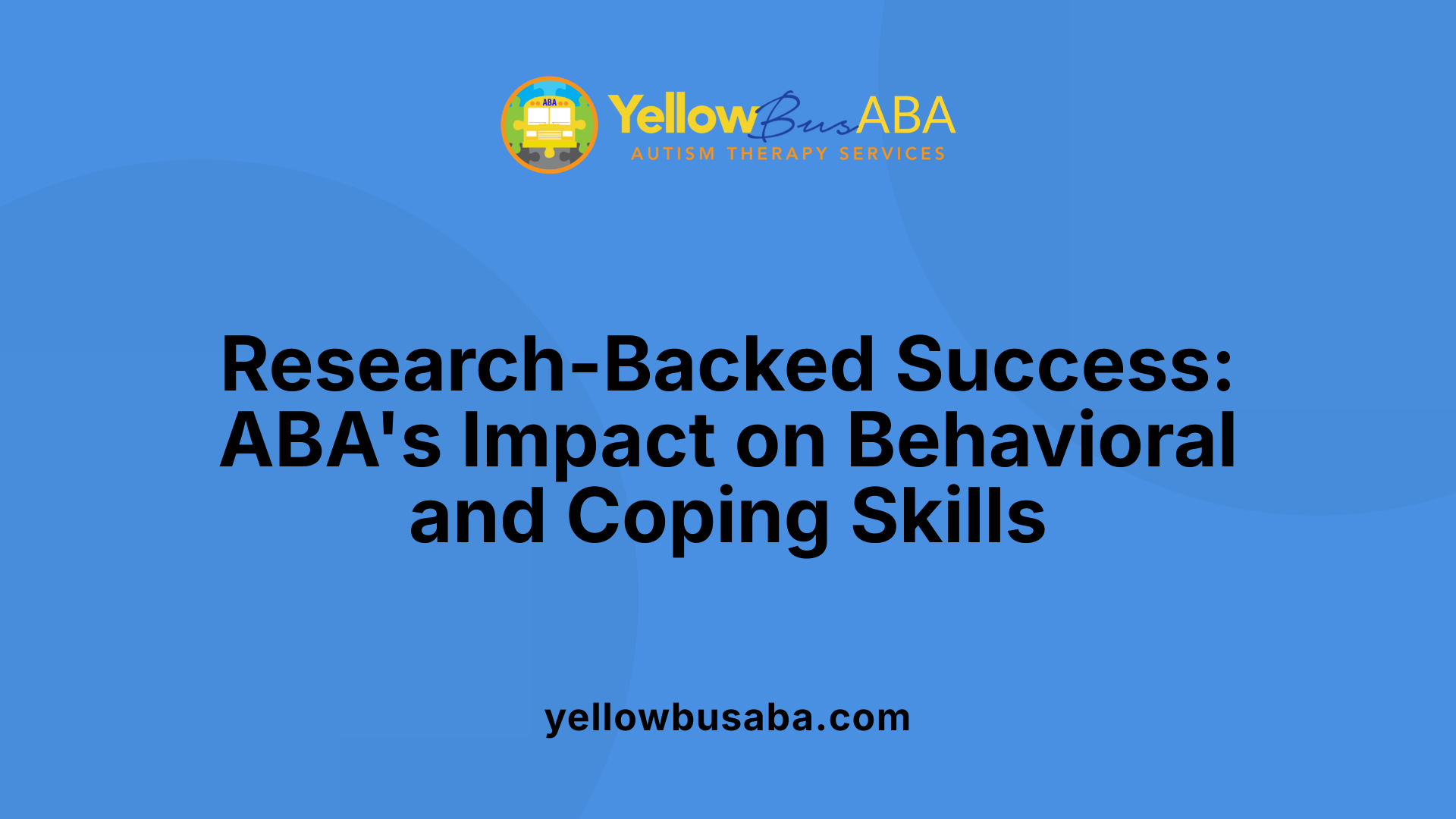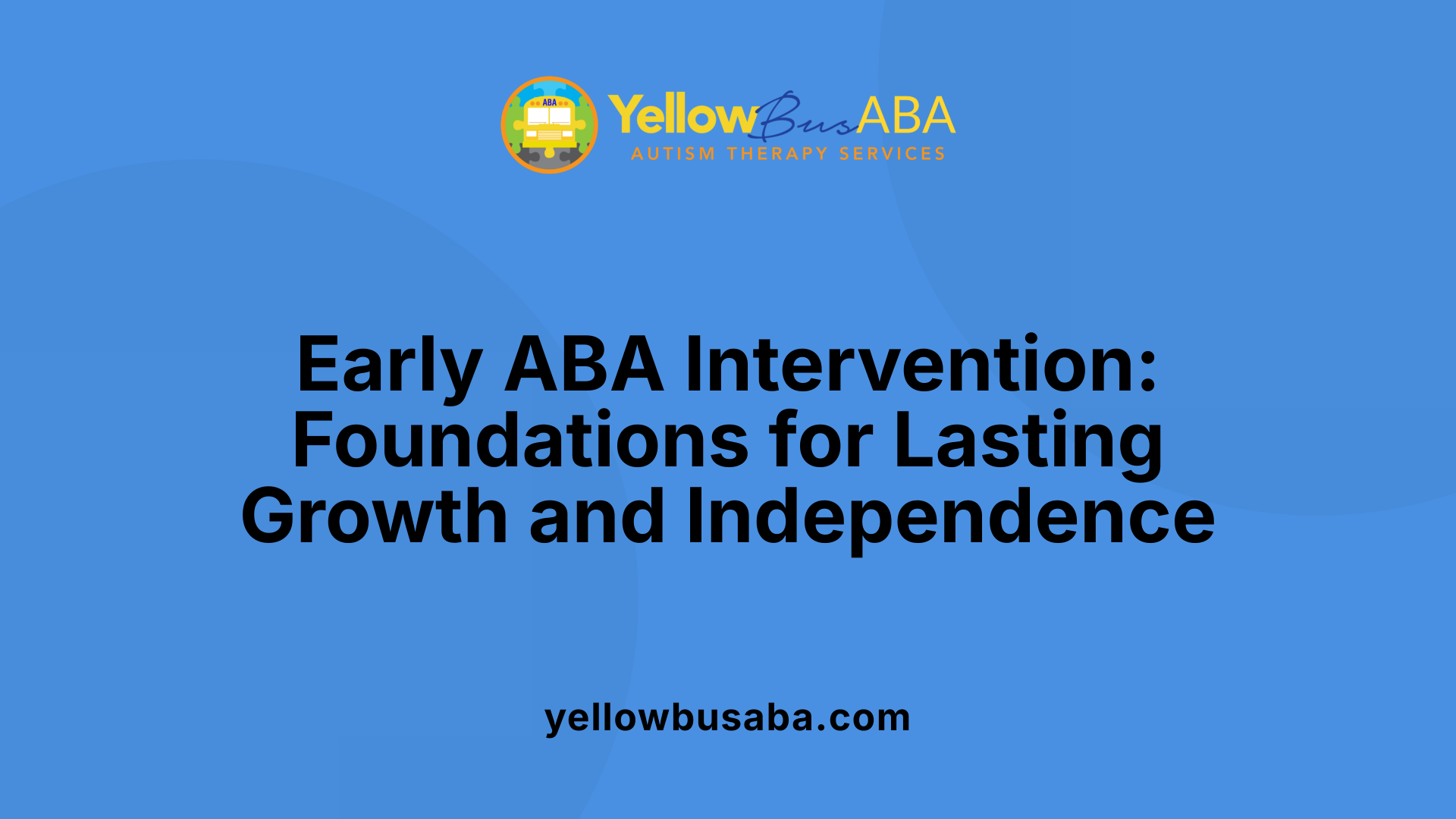Understanding ABA Therapy's Vital Role
Applied Behavior Analysis (ABA) has emerged as the cornerstone of evidence-based intervention for children with autism. Its structured, individualized approach not only enhances communication and social skills but also plays a crucial role in developing coping mechanisms and emotional regulation abilities among young learners. This comprehensive overview explores how ABA therapy can significantly improve the quality of life for children by fostering resilience, independence, and social integration.
The Impact of ABA on Social and Communicative Skill Development

How effective is ABA therapy in improving social and coping skills among children with autism?
Research consistently demonstrates that applied behavior analysis (ABA) significantly enhances social and communication skills in children with autism. Studies have shown that a substantial portion, approximately 68-70%, of children undergoing ABA experience notable improvements in areas such as language, social interactions, and daily functioning.
ABA therapy is especially effective when delivered through intensive, individualized programs that focus on the child's unique needs, strengths, and interests. These programs typically include techniques such as positive reinforcement, visual supports like picture exchange systems, role-playing, and social simulations. These methods help children develop essential skills, including eye contact, turn-taking, emotion recognition, and managing social cues.
Furthermore, ABA therapy's structured approach aids in reducing challenging behaviors like tantrums and aggression, replacing them with functional and adaptive skills. This comprehensive approach not only promotes immediate skill acquisition but also supports long-term behavioral changes.
While a small percentage of studies include robust comparison groups, the overarching consistency of results confirms ABA as the preferred, evidence-based intervention for fostering social growth in children with autism.
The long-term benefits of ABA extend beyond immediate skill improvements. Children who receive early and sustained ABA intervention tend to demonstrate better social participation, increased independence in daily activities, and resilience in coping with emotional challenges.
In summary, ABA has proven to be a powerful tool in improving social, communicative, and coping skills among children with autism, significantly contributing to their development and quality of life.
ABA's Role in Teaching Emotional Regulation and Coping Strategies

What is the role of ABA therapy in developing coping strategies and emotional regulation skills in children with autism?
ABA therapy is integral to helping children with autism learn how to manage their emotions and develop effective coping mechanisms. Using a variety of tailored, evidence-based techniques, ABA creates a structured environment in which children can understand and regulate their feelings.
A central aspect of ABA involves methods like positive reinforcement and modeling behaviors that exemplify healthy emotional responses. For instance, therapists may employ role-playing exercises to simulate potential emotional triggers, allowing children to practice appropriate responses in a safe, controlled setting.
Visual supports are often used within ABA to enhance understanding. These can include visual schedules, emotion cards, or social stories that help children identify their feelings and learn coping strategies. Sensory tools, such as calming bottles or noise-canceling headphones, assist children in managing sensory overloads that often overwhelm children with autism.
One of the core objectives of ABA in this context is to teach children how to recognize their emotions and respond calmly rather than engaging in challenging behaviors like tantrums or aggression. Techniques like deep breathing exercises, taking a break in a quiet space, or using coping cards are systematically taught and reinforced.
To ensure carryover and consistency, ABA strategies involve parents and caregivers, providing them with tools and routines that support emotional regulation across different settings. This approach promotes generalization, helping children apply learned skills in school, at home, and within the community.
By systematically breaking down complex emotional experiences into manageable steps and reinforcing positive responses, ABA fosters resilience and emotional intelligence in children with autism. The therapy enhances their ability to face social and environmental challenges confidently, improving their overall well-being.
In summary, ABA therapy's focus on individualized, evidence-based interventions facilitates significant improvements in emotional regulation and coping skills. This support not only reduces problematic behaviors but also equips children with essential abilities to navigate their environments more effectively and develop healthier social connections.
Techniques That Foster Behavioral Management and Skill Acquisition

How do ABA therapy techniques help children with autism manage their behaviors and enhance coping mechanisms?
Applied Behavior Analysis (ABA) employs various structured techniques to support children with autism in developing better behavior management and coping skills. These methods are rooted in evidence-based principles and focus on teaching new, functional behaviors while reducing challenging actions.
One core approach is positive reinforcement, which rewards desirable behaviors, encouraging children to repeat these actions. For example, praising a child for initiating a conversation or completing a task can increase their motivation to engage.
Visual supports play an important role by providing clear visual cues such as picture schedules, social stories, or visual timers. These aids cater to children’s strong visual learning tendencies, helping them understand expectations, manage transitions, and grasp social and emotional concepts more effectively.
Behavior chaining involves breaking complex skills into smaller, manageable steps, teaching each step sequentially, and linking them together until the entire behavior is mastered. This method is especially useful for teaching routines like handwashing or dressing.
Natural environment teaching (NET) is an innovative approach that involves embedding learning opportunities into everyday activities and settings. This promotes real-world applicability and helps children generalize skills across different environments.
Targeted techniques such as video modeling utilize recordings of behavior demonstrations, allowing children to imitate social and communication skills visually. This method leverages their natural tendency for imitation and can improve social interactions and emotion recognition.
Script fading and prompting techniques involve giving cues or prompts to guide behavior initially, then gradually reducing assistance as the child becomes more independent. This gradual withdrawal helps enhance self-reliance.
Collectively, these ABA techniques create a comprehensive framework that not only reduces disruptive or inappropriate behaviors but also actively develops communication, social, and emotional skills. As children learn to navigate their environments more effectively, they are better able to cope with stressors and complex social situations, leading to overall improvements in their adaptive functioning.
The Significance of Consistency and Caregiver Participation

Why is consistency and caregiver involvement important in ABA therapy for improving coping skills in children with autism?
Consistency and active participation by caregivers are crucial components of effective ABA therapy, especially when it comes to developing coping skills in children with autism. These elements ensure that the skills children acquire during structured therapy sessions are reinforced and practiced regularly in various settings, including at home, school, and community environments.
When parents and caregivers are involved, they can help promote the generalization of skills. This means children are more likely to apply learned behaviors beyond the therapy setting, leading to meaningful improvements in daily life. For instance, if a child learns to recognize and cope with emotions through therapy, consistent reinforcement by caregivers helps solidify this skill, making it a natural part of their emotional responses.
Engaged caregivers also enable more frequent practice of new skills, which accelerates development in areas such as social communication, adaptive behaviors, and emotional regulation. They collaborate with therapists to set appropriate goals and to understand the strategies used during interventions. Participating in training empowers caregivers to implement techniques consistently, such as positive reinforcement and social stories, which are proven to reinforce desired behaviors.
Furthermore, caregiver involvement reduces the gap between therapy sessions and real-world application. When families actively engage, children experience a supportive learning environment at home and in their community, which boosts confidence and encourages independence.
Research highlights that consistent routines, combined with family participation, significantly improve long-term outcomes for children with autism. It helps them develop the resilience and skills needed to handle everyday challenges, including emotional stress and social interactions.
Ultimately, fostering an environment of collaboration between therapists and families enhances the child's learning experience, increases their independence, and leads to more sustainable progress in coping skills. It also empowers families to support their child's ongoing development, creating a foundation for a more inclusive and adaptable future.
Research Evidence Supporting ABA's Effectiveness in Coping and Behavioral Improvements

What are some research findings regarding the impact of ABA therapy on coping and behavioral improvements in children with autism?
Research consistently demonstrates that ABA therapy can lead to meaningful gains in social, emotional, and behavioral skills among children with autism. Multiple studies, including randomized control trials and repeated measurements, reveal that targeted behaviors—such as social interactions, communication, and daily living skills—improve markedly over relatively short periods. These improvements are statistically significant, with p-values often less than 0.001, indicating strong evidence of efficacy.
Meta-analyses and systematic reviews further support these findings, showing large effect sizes for enhancements in IQ, language development, and overall adaptive functioning. When implemented intensively, typically 25-40 hours per week, ABA programs tend to produce the most substantial outcomes. Specific techniques like positive reinforcement, task analysis, visual supports, and natural environment training directly contribute to these behavioral advancements.
Moreover, ABA therapy has proven effective in reducing problematic behaviors such as tantrums, aggression, and self-injury by identifying and addressing behavioral triggers and replacing maladaptive actions with functional skills.
Quantitative Outcomes of ABA Interventions
| Outcome Domain | Mean Improvement | Effect Size | Supporting Details |
|---|---|---|---|
| Social Skills | 30-50% increase | Large | Improvements in eye contact, turn-taking, and friendship-building |
| Communication | 20-45% enhancement | Large | Gains in verbal skills, picture exchange, and requesting methods |
| Adaptive Behaviors | 25-50% improvement | Large | Skills like hygiene, dressing, and household tasks |
| Problem Behaviors | 40-60% reduction | Moderate to large | Decrease in tantrums, aggression, self-injury |
| Emotional Regulation | Not quantifiably measured | N/A | Improved ability to identify and cope with emotions |
Long-term Benefits of ABA Therapy
Early, intensive ABA interventions—especially when started before age six—are associated with long-lasting improvements. Children tend to sustain gains in cognitive abilities, language, and social skills, which can translate into better academic performance, increased independence, and improved quality of life.
However, some limitations exist. Many studies lack extensive long-term follow-up and generalization assessments, raising questions about the durability of these improvements beyond structured therapy sessions.
Research indicates that ongoing support and booster interventions may help maintain gains over time. Despite the limitations, the overall evidence underscores ABA's potential to foster resilience, emotional intelligence, and social competence in children with autism.
| Aspect | Details | Notes |
|---|---|---|
| Strength of Evidence | Consistent findings across multiple studies | Large effect sizes for key developmental domains |
| Gaps in Research | Need for long-term, real-world outcome studies | More focus on quality of life measures needed |
| Variation in Results | Effectiveness varies with intervention intensity and individual needs | Tailoring programs is crucial |
| Methodological Limitations | Small sample sizes in many studies | Larger, controlled studies are necessary |
This body of evidence supports the vital role of ABA therapy not only in improving immediate behavioral and social skills but also in promoting the ongoing development and well-being of children with autism. Continuous research and tailored intervention strategies remain essential to maximize long-term positive outcomes.
Early Intervention and the Long-Term Impact of ABA

Why is early intervention with ABA particularly beneficial for children with autism?
Initiating ABA therapy early, ideally before the age of six, harnesses the heightened neuroplasticity present during early childhood. This period is crucial because the developing brain is more receptive to learning new skills, making it the optimal window for interventions. When children receive intensive ABA therapy during this phase, they often exhibit more significant improvements in essential areas such as language, social interaction, and adaptive behaviors.
Research consistently shows that early ABA treatment results in better developmental outcomes. Children tend to perform better academically, demonstrate higher levels of independence, and exhibit more refined emotional regulation skills as they grow older.
Furthermore, early intervention helps children navigate sensory sensitivities and environmental challenges common in autism, such as hypersensitivity to noise or bright lights. By addressing these issues early on, children are better equipped to manage stress and adapt to social and educational environments.
The benefits of starting ABA early extend beyond immediate skill acquisition. They lay a solid foundation for long-term resilience and well-being. Children who begin therapy early are more likely to develop the skills necessary for meaningful social relationships, employment, and community participation in adulthood. This proactive approach significantly improves their overall quality of life, promoting independence and emotional stability.
Overall, early ABA intervention acts as a catalyst for comprehensive growth, supporting children with autism in reaching their full potential and fostering sustainable development across multiple domains.
Future Directions and Research Needs in ABA Therapy

What are some research gaps and future directions in understanding ABA's impact on children with autism?
While the existing body of research supports the positive influence of Applied Behavior Analysis (ABA) on children with autism, several important gaps remain that warrant further investigation.
Many studies to date have involved small sample sizes, with some including fewer than three participants. This limits the ability to generalize findings across diverse populations. Larger, more comprehensive studies are needed to confirm the consistency of ABA's benefits across different age groups, severity levels of autism, and cultural backgrounds.
Another significant limitation is the lack of long-term follow-up data. Most studies measure improvements shortly after intervention, but few assess whether these gains are maintained over months or years. Understanding the durability of ABA's effects is crucial for demonstrating its lasting value and for refining strategies that promote sustained development.
Comparative studies are also sparse. There is a need for well-designed, prospective research that compares ABA directly with other interventions such as speech therapy, social skills training, or innovative approaches like technology-assisted therapies. Such comparisons can help determine the relative strengths and limitations of ABA.
Additionally, most assessments focus on skill acquisition rather than quality of life (QoL). Future research should include measures of emotional well-being, resilience, social participation, and overall life satisfaction to provide a holistic view of outcomes.
There is also a call for the development and standardization of outcome measures that evaluate how well learned skills generalize to everyday environments such as home, school, and community settings. Incorporating generalization and transfer assessments will better reflect real-world applicability.
How can addressing these limitations improve ABA therapy?
By tackling these research gaps, future studies can refine ABA techniques, optimize intervention timing and intensity, and enhance its overall effectiveness. Large-scale, longitudinal research will provide clearer evidence about which strategies lead to durable improvements and high-quality life outcomes.
Furthermore, comparative studies can inform best practices and shape policy decisions, ensuring children with autism receive the most effective and personalized care.
Ultimately, advancing research in these areas will support the development of evidence-based guidelines that maximize the benefits of ABA, helping more children achieve their full potential and enjoy improved quality of life.
Summary and Final Thoughts on ABA's Role in Coping Skill Development

What does the evidence say about ABA's impact on children with autism?
The research consistently demonstrates that Applied Behavior Analysis (ABA) significantly enhances social and communication skills in children with autism, particularly in institutional settings. Studies involving 60 children aged 4 to 11 showed that after undergoing structured ABA sessions, children exhibited notable improvements in social behaviors, communication, and adaptive skills. These outcomes were measured using tools like the Kindergarten Inventory of Social/Emotional Tendencies (KIST), highlighting reductions in separation anxiety and increases in coping strategies. Most findings—over 63%—reported positive changes across multiple developmental areas.
Why is ABA considered the gold standard in supporting children with autism to develop coping mechanisms?
ABA stands out as the most scientifically supported approach because of its solid empirical basis and customized intervention techniques. The therapy employs methods like positive reinforcement, direct instruction, and natural environment training to teach children essential coping skills. This approach systematically helps children identify and manage their emotions, reduce challenging behaviors such as tantrums or aggression, and develop independence.
Because ABA programs are tailored to each child's specific needs, strengths, and preferences, they promote meaningful engagement and skill acquisition. The focus on functional behaviors allows children to learn practical coping strategies applicable to daily life. Long-term studies suggest that skills learned through ABA are durable, fostering emotional resilience and better social integration. This effectiveness, combined with its adaptability, underpins its status as the preferred treatment for supporting children in managing stress and navigating social environments.
What are the benefits of early, individualized ABA interventions?
Starting ABA therapy early—preferably before age six—maximizes developmental gains. Early intervention leverages the brain's plasticity, making it easier for children to learn new skills and integrate them into daily routines. Individualized ABA sessions address each child's unique challenges and abilities, ensuring targeted support in areas like communication, social skills, self-help, and emotional regulation.
In addition to improving communication and social interactions, ABA enhances daily living skills such as hygiene and dressing. It also prepares children for real-world challenges by teaching them to recognize social cues, regulate emotions, and develop resilience. The flexibility of ABA techniques allows educators and therapists to include methods like social stories, role-playing, and positive reinforcement, making learning relevant and engaging. Overall, early, tailored ABA interventions set a strong foundation for lifelong coping and adaptive skills.
What are long-term benefits of ABA for children with autism?
Research indicates that intensive ABA therapy can lead to sustained improvements in cognitive, language, social, and behavioral domains. Children who receive early and consistent intervention are more likely to show lasting gains in their ability to communicate, form relationships, and handle daily tasks independently.
While some studies reveal the need for more comprehensive long-term data, existing evidence suggests that ABA helps foster emotional regulation, reduce problematic behaviors, and promote adaptive functioning over time. These improvements contribute significantly to the overall quality of life, increasing resilience and social participation.
Summarizing the effectiveness of ABA in fostering coping skills
In summary, ABA is a structured, evidence-based approach that plays a crucial role in developing coping mechanisms in children with autism. Its individualized nature ensures that interventions are aligned with each child's unique profile, maximizing engagement and learning.
Early implementation of ABA yields considerable long-term benefits, including better emotional resilience, functional independence, and social competence. While ongoing research continues to refine its methods, the current body of evidence affirms ABA’s central role in supporting children with autism to navigate their environments more effectively, ultimately improving their overall well-being.
Empowering Children with Autism through Evidence-Based Strategies
ABA therapy stands out as a scientifically validated and versatile approach for enhancing not only cognitive and social skills but also vital emotional and coping abilities in children with autism. Its individualized, consistent application—coupled with active caregiver involvement—ensures that children acquire sustainable skills to handle stresses, environment changes, and social challenges. Continued research and adaptation of ABA techniques will further solidify its role in improving life quality, fostering resilience, and enabling children with autism to thrive in diverse settings. As the field advances, embracing these evidence-based practices can open new pathways toward more independent, emotionally balanced, and socially integrated lives for children on the spectrum.
References
- The effectiveness of applied behavior analysis program training on ...
- Top 7 Benefits Of ABA Therapy For Autistic Children
- Unit 10: Coping Skills Development in Early Intervention - AutismCOE
- Applied Behavior Analysis in Children and Youth with Autism ...
- 6 Life-Changing Benefits of ABA Therapy for Children with Autism
- The Role of Caregiver Involvement in ABA Therapy
- Impact of ABA Therapy: The Key Role of Parental Involvement
- Caregiver Involvement is Possible and Encouraged with Center ...
- Parent Involvement in ABA Therapy - Surpass Behavioral Health
- The Importance of Caregiver Involvement - Bright Path Behavior






